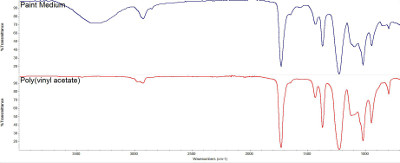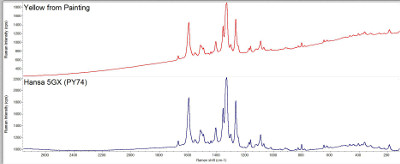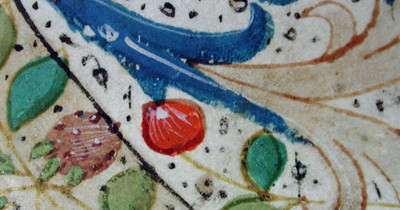Spotlight on: Art Analysis
Micro-analysis of artwork and antiques can provide important information to collectors and conservators attempting to establish authenticity or determine best conservation methods. Microtrace scientists can utilize a variety of analytical techniques to understand the individual components of a work of art. Our analyses can reveal compositional information on pigments and media in paints, metals in bronze alloys, fibers used to make a canvas, and the types of polymers in a modern sculpture. Once the materials in the artwork have been identified, we can compare this data with known information about an artist’s palette or the dates of use for certain materials. A few examples of this type of work are described below.
A European Impressionist art connoisseur was evaluating a painting in order to provide a report prior to its sale. The expert noticed that one of the colors in the painting did not seem visually consistent with other works by the same artist. He requested an analysis in order to identify the pigments in the painting and compare them to those of the artist’s known palette. The key pigment, Viridian (hydrated chrome oxide), was identified in the questioned region of the painting. Viridian is a documented pigment in the artist’s palette. Analysis of the varnish layers above the questioned area showed that one varnish layer had yellowed considerably with age. This yellowing of the varnish was the real reason for the suspicious hue of the green area of the painting. Because the painting was mainly composed of shades of yellow, the varnish had not visually impacted the evaluation of these other regions as dramatically.
Another similar project involved a work attributed to the 20th century artist Yves Klein. Klein was known for his use of blue canvasses created with ultramarine blue pigment and a synthetic resin binder called polyvinyl acetate. Notably, he prepared the ultramarine blue in this modern synthetic resin rather than in a traditional oil medium. Fourier-Transform Infrared (FTIR) analysis of blue paint samples from the canvas in question did show the modern synthetic resin. However, the blue pigment used in the paint was not ultramarine blue, but a mixture of phthalocyanine blue and dioxazine violet. This result indicated the painting was more likely done in the style of Klein, but not by Klein himself.

FTIR comparison of the actual paint medium used in alleged work by Yves Klein (top) to Klein’s known synthetic binder (bottom).
Jackson Pollock is famously known for his drip paintings which have recorded exceptional sale prices at auctions. With this lucrative motivation, there have been many cases of paintings “recently discovered” and attributed to Pollock. When subjected to forensic analysis, many of these paintings have been identified as forgeries. One drip style painting attributed to Jackson Pollock included a signature and was dated 1947. It was analyzed to identify the materials used in the painting. The pigment of one of the prominent yellow paints on the artwork was identified by Raman spectroscopy as Hansa Yellow PY74. The problem- this pigment was first introduced for use in 1957. Jackson Pollock was killed in a car accident in 1956, so he could not have created the painting.

Raman spectragraph comparison of the observed yellow pigment used in an alleged painting by Jackson Pollock (top) to PY74, a pigment which was first introduced after Pollock’s death (bottom).
Microtrace’s analysis of artwork makes excellent use of collections of materials used by artists. Curated collections include pigments, natural and synthetic fibers, minerals, woods, polymers and metals. Our in house colorant collection includes over 22,000 pigments, dyes, and color shade cards along with databases generated from these materials using microscopic and spectroscopic methods. We have also conducted several research grants aimed at developing the forensic analysis of paint. An analysis of material components used in a work of art can produce objective data that we can compare to known information on materials both available to and used by the artist.
If you are interested in discussing an analysis of your artwork, please contact Microtrace to speak to one of our scientists. We can develop a plan of analysis to address your specific authentication, materials identification, or conservation projects.
How May We Help You?
Contact usto discuss your project in more detail.









